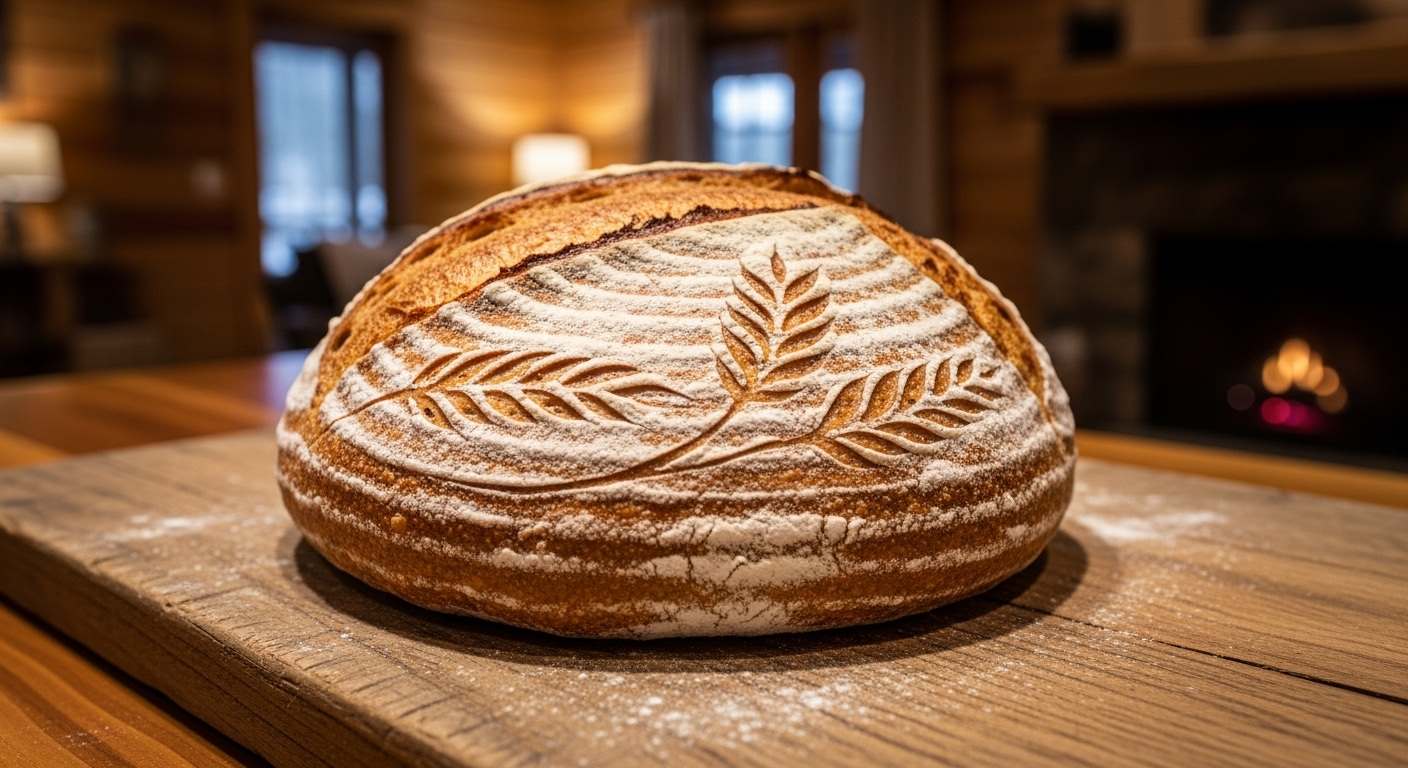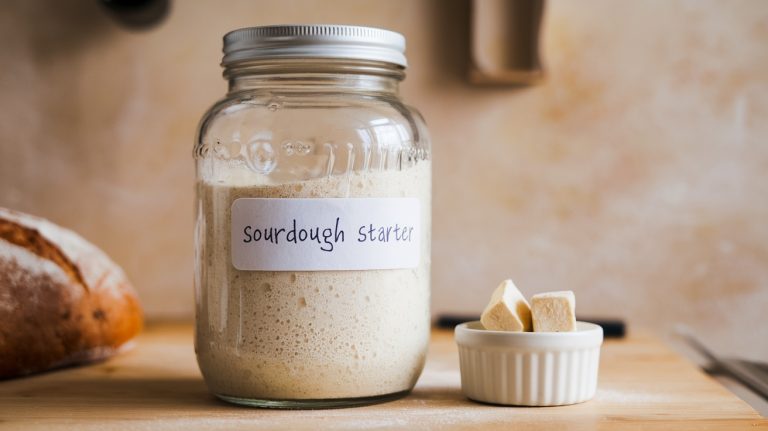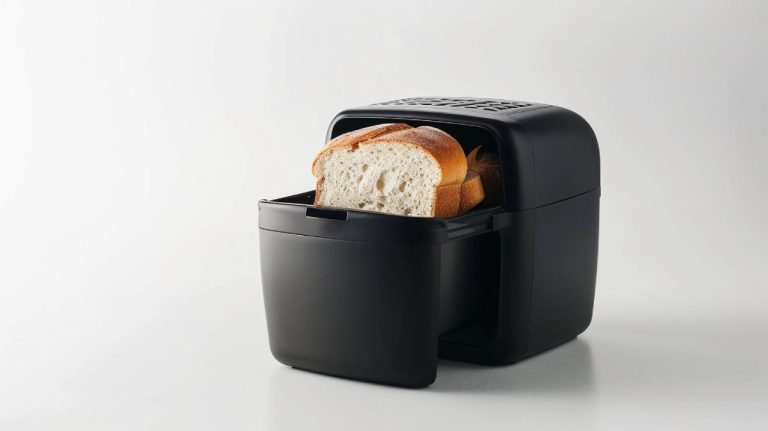High Altitude Sourdough Bread Recipe with Secret Tips
At high altitude, you’ll need to reduce your sourdough starter by about 25% and increase hydration by 5-10% to combat drier air and rapid fermentation.
Use colder water to slow yeast activity and monitor bulk fermentation closely. Consider refrigerating or shortening it.
Raise oven temperature roughly 25°F to offset quicker evaporation and lower boiling points. Aim for an internal bread temperature near 195°F.
These precise tweaks avoid over-proofing and dryness, setting the stage for more advanced techniques ahead.
Key Takeaways
- Reduce sourdough starter by 25% and use colder water to slow fermentation and control dough temperature at high altitude.
- Increase dough hydration by 5-10% to compensate for dry flour and environment, ensuring a soft, manageable dough.
- Perform bulk fermentation in the refrigerator or shorten fermentation time to prevent over-proofing and dough collapse.
- Raise oven temperature by 25°F and monitor internal bread temperature around 190°F for optimal baking results.
- Use additional folds during fermentation to strengthen gluten and cover dough to prevent surface drying and tough crust formation.
Complete High Altitude Sourdough Bread Recipe
| Ingredient | Standard Recipe | High Altitude Adjustment | Final Amount | Notes |
|---|---|---|---|---|
| Bread Flour | 500g | No change | 500g | Use high-protein flour for better structure |
| Water | 375g | Increase 5-10% | 395-410g | Use cold water to slow fermentation |
| Active Sourdough Starter | 100g | Reduce by 25% | 75g | Less starter prevents over-proofing |
| Salt | 10g | No change | 10g | Add after autolyse for better gluten development |
| Oven Temperature | 450°F | Increase by 25°F | 475°F | Compensates for faster evaporation |
| Bulk Fermentation | 4-6 hours | Reduce by 30% | 3-4 hours | Monitor dough volume closely |
| Final Proof | 2-3 hours | Reduce by 50% | 1-1.5 hours | Watch for proper rise |
| Baking Time | 45 minutes | Reduce by 10% | 40 minutes | Target 195°F internal temperature |
Impact of High Altitude on Sourdough
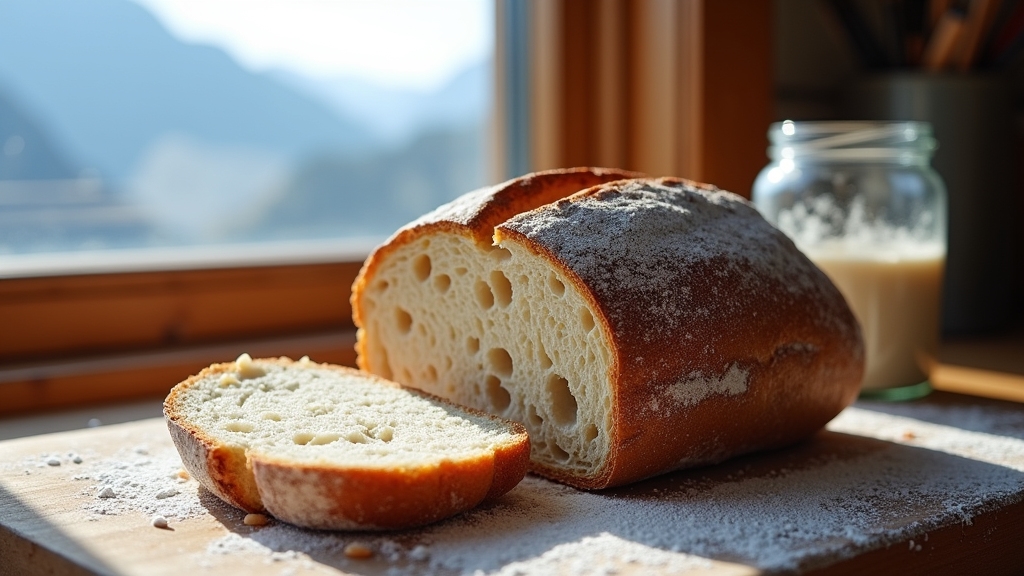
How does high altitude affect your sourdough fermentation?
At higher elevations, reduced air pressure causes fermentation gases to expand faster, accelerating bulk fermentation and proofing. This rapid gas expansion can lead to over-fermented dough that becomes slack, overly bubbly, and sticky.
Reduced air pressure at high altitudes speeds gas expansion, accelerating fermentation and proofing times.
Such dough often collapses after scoring, resulting in dense, gummy crumb and poor oven spring. Many bakers find that controlling temperature and timing is crucial for maintaining dough quality under these conditions.
Additionally, lower humidity typical of high altitudes dries out your dough surface quickly, causing a tough skin that inhibits proper crust development. Flour at high altitudes absorbs water more quickly due to the dry air, requiring careful hydration adjustments to maintain dough consistency.
Temperature fluctuations further amplify these effects by speeding yeast and bacterial activity, necessitating precise temperature control to avoid over-proofing. Monitoring temperature is especially important since precise temperature control improves fermentation consistency.
Mechanically, the weakened gluten structure from rapid gas expansion makes shaping and scoring more challenging. This requires you to monitor dough feel closely throughout fermentation to maintain dough integrity.
Adjusting Ingredients and Hydration Levels
Because high-altitude environments cause flour to absorb moisture differently and fermentation to accelerate, you’ll need to carefully adjust both your ingredient ratios and hydration levels.
Start by increasing hydration 5-10% to compensate for drier flour, especially with whole wheat or rye. Reduce your sourdough starter by about 25% to slow fermentation and prevent over-proofing. It is also important to monitor the dough closely rather than relying solely on time, as fermentation duration can vary widely at high altitude. Using a digital kitchen scale can help ensure you maintain precise ingredient measurements despite environmental changes.
Use slightly colder water to lower dough temperature, controlling enzymatic activity and fermentation speed.
- Begin with 350 g water per 500 g flour; add more post-autolyse if dough feels dry.
- Cut starter amount to moderate rapid yeast and bacterial activity.
- Employ colder water to maintain dough development time and prevent premature gluten breakdown.
These adjustments will help you maintain dough softness, structure, and flavor balance at altitude.
Optimizing Dough Handling and Fermentation
Adjusting your ingredient ratios and hydration levels sets the stage for effective dough handling and fermentation control at high altitude.
Decrease your sourdough starter by about 25% to slow rapid fermentation caused by lower air pressure.
Use colder water during mixing to reduce dough temperature, extending fermentation and preventing over-proofing. Ensure ingredients are at room temperature beforehand to promote proper emulsion and consistency.
Conduct bulk fermentation in the refrigerator or shorten its time while monitoring dough volume closely. Remember that hydration levels may need to be increased or decreased based on humidity and flour dryness to achieve optimal dough consistency.
Perform additional folds to strengthen gluten and regulate fermentation speed.
Increase hydration incrementally after autolyse to counteract dry air and flour absorption, ensuring your dough passes the Window Pane Test for ideal gluten development.
Cover dough to prevent moisture loss, and incorporate more frequent stretches and folds to maintain dough structure.
Carefully time rises and punch down dough once or twice to redistribute gases and promote even fermentation.
Tailoring Baking Techniques for Altitude
When baking sourdough at high altitude, you’ll need to raise your oven temperature by about 25°F to counteract faster evaporation and the lower boiling point of water. This adjustment helps guarantee proper crust development and internal cooking.
Additionally, you should decrease the amount of yeast by about 25% to slow the fermentation process and prevent overproofing at altitude, which can cause the dough to collapse due to faster fermentation. Using a digital instant-read thermometer ensures you get accurate temperature readings for optimal baking results.
To tailor your baking techniques effectively:
- Reduce the target internal bread temperature by approximately 5°F near 7,000 ft, preventing overbaking and dryness.
- Monitor crust color vigilantly; faster browning requires adjusting baking time to avoid burning.
- Use a digital instant-read thermometer to confirm the bread reaches around 195°F, adjusting for altitude-induced boiling point changes.
These precise changes compensate for atmospheric pressure variations, optimizing moisture retention, crumb texture, and crust quality in your high-altitude sourdough baking.
Troubleshooting Common High Altitude Baking Challenges
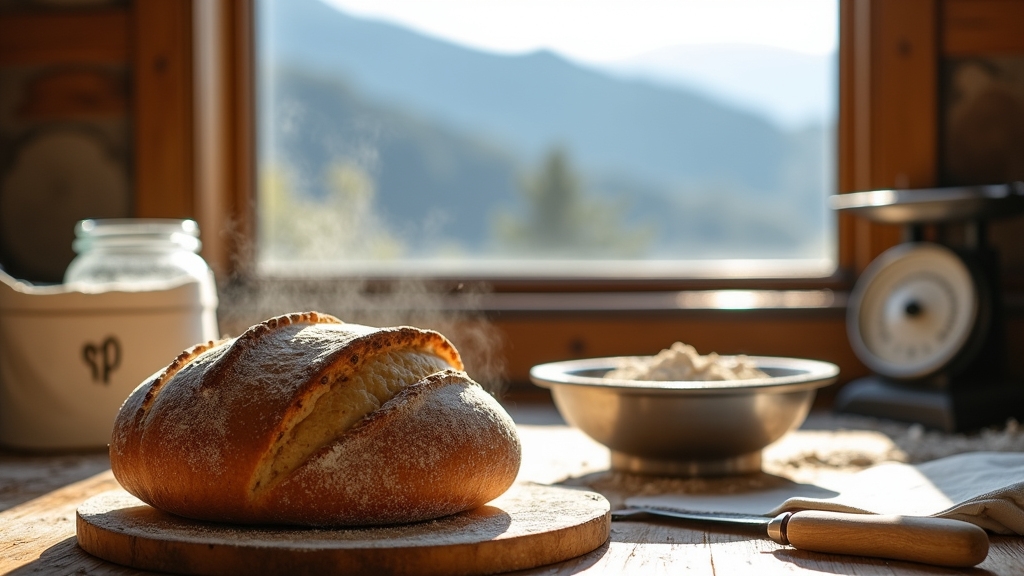
Although high altitude baking presents unique challenges, you can overcome them by systematically addressing common issues such as over-proofing, rapid moisture loss, and structural instability. Using a digital scale can help ensure precise ingredient measurements, which is crucial for consistent results at high altitude.
Reduce leavening agents by 20–50% depending on elevation to prevent collapsing. Increase liquids slightly to combat dryness. Raise oven temperature 15–25°F but shorten baking time to avoid over-browning and dryness. Strengthen dough by adding extra flour incrementally to support structure and improve dough resilience by incorporating high-protein flour.
| Issue | Cause | Adjustment |
|---|---|---|
| Over-proofing | Rapid yeast activity | Reduce yeast by 25%, refrigerate |
| Moisture loss | Dry, thin air | Increase liquids, use starter |
| Structural collapse | Excess rising pressure | Cut leavening, add flour |
| Over-browning | Increased oven temp | Shorten bake time, use foil shield |
Frequently Asked Questions
Can I Use Store-Bought Yeast Instead of Sourdough Starter at High Altitude?
Yes, you can use store-bought yeast instead of sourdough starter at high altitude, but you’ll need to reduce the yeast amount to prevent overproofing due to faster fermentation.
Increase hydration slightly, perform frequent stretch and folds to strengthen gluten, and raise the oven temperature by about 25°F.
Keep a close eye on proofing stages to avoid collapse. This substitution sacrifices sourdough’s flavor complexity but offers predictability and faster rise times.
How Do Altitude Adjustments Differ for Rye or Gluten-Free Sourdough?
You’ll find rye sourdough needs more hydration and fewer starter amounts than gluten-free to counteract rapid fermentation and weaker gluten at altitude.
Rye demands shorter bulk fermentation and extra folds to reinforce structure.
Gluten-free requires binders like xanthan gum and cooler proofing to prevent collapse.
Both benefit from higher oven temperatures, but gluten-free doughs need gentler handling and precise hydration tweaks due to their fragile nature and lack of gluten.
What Are the Best Alternatives to Dutch Ovens for High Altitude Baking?
You’ll find cast iron skillets with vented lids or heavy foil covers excellent, as they retain heat and trap steam like Dutch ovens.
Ceramic casserole dishes and preheated clay pots also work well, promoting even heat and moisture.
Using roasting pans covered tightly with foil mimics steam environments, but monitor for uneven heating.
Always adjust baking times and moisture to compensate for high altitude’s effects on dough behavior and heat distribution.
How Does Seasonal Humidity Variation Impact Sourdough Hydration Adjustments?
You’ll often need to reduce dough hydration by up to 5% during very humid seasons.
Flour absorbs more moisture from the air, making dough wetter at the same water ratio.
This extra moisture speeds fermentation, so you must adjust water amounts carefully—usually in 25g increments.
Monitor dough texture closely.
Using cold water and reducing starter can help control fermentation and maintain gluten structure despite humidity fluctuations.
Can I Freeze High Altitude Sourdough Dough or Baked Bread Effectively?
Yes, you can freeze high altitude sourdough dough and baked bread effectively if you follow specific steps.
Cool baked bread completely before slicing and wrap it tightly in plastic, foil, and a freezer bag to prevent freezer burn.
Freeze dough after the first fermentation, shaped and airtight in containers or bags.
Thaw bread wrapped to avoid condensation. Thaw dough slowly in the fridge and proof fully before baking to maintain texture and rise quality.
Start Your Mountain Sourdough Adventure Now
Baking sourdough at high altitude means adjusting hydration, managing fermentation, and mastering oven temperatures.
You’ll balance flour and water to achieve elasticity, control proofing times to avoid overexpansion, and fine-tune your bake for a crisp crust and tender crumb.
By understanding altitude’s effects, tweaking each step, and troubleshooting patiently, you transform challenges into triumphs.
This creates bread that rises evenly, tastes complex, and feels light, airy, and perfectly textured every time.

